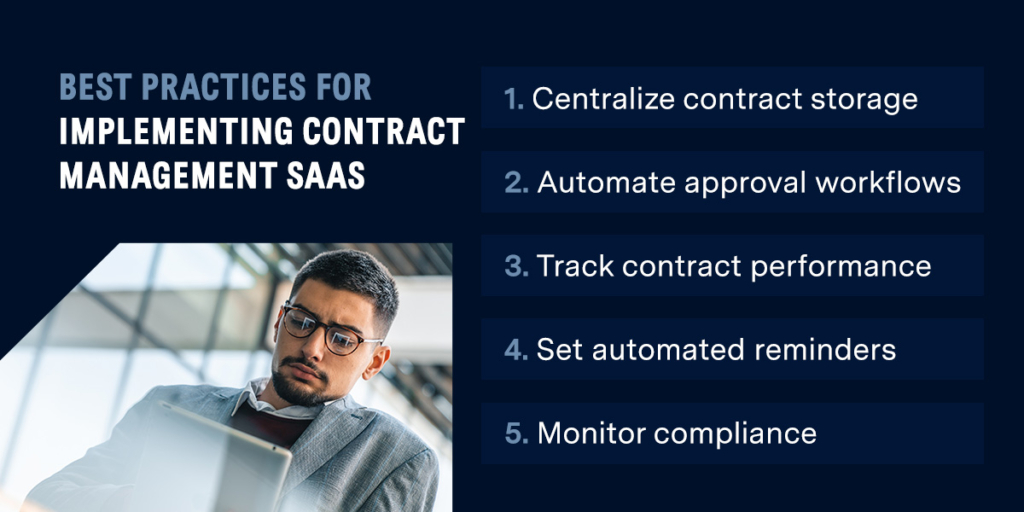
SaaS contract management best practices
Cloud-based Contract Management Saas manages the entire organization’s contract creation, negotiation, signature, renewal, and more.

Contracts, in theory, should be manageable to support. Two or more organizations or parties get together to designate the contract rights and obligations. Both organizations or parties consent and then abide by their entire agreement. If issues occur, everyone can reference the contract to resolve problems.
However, contract management has become more complex. For example, digital licensing agreements across platforms make it challenging to track everything. The complexity of cloud-based Contract Lifecycle Management (CLM) software is ever increasing, keeping pace with these demands.
This is where cloud-based CLM comes in. These platforms are designed to support your entire business and each of its contract agreements.
What is contract management SaaS?
Cloud-based contract management Software as a Service (SaaS) manages the entire organization’s contract creation, negotiation, signature, renewal, and contract data analysis of legal contracts. The best cloud-based contract management software SaaS applications enable organizations and top-level business sales teams to self-serve, agree, and handle quick routine contracts and agreements at scale from a single, unified workspace.
A large enterprise may manage thousands of contracts per month. Making a move to digital technology, rather than using a hard copy, is transformative for efficiency, speed, and operating costs. Providers of cloud-based contract lifecycle management can create an easy-to-use contract management strategy via digital workflows and contracts, tailoring them to the company’s unique needs.
First, it’s important to demystify the key dialect around cloud-based contract management software SaaS applications.
Contract terminology
- Contract lifecycle: The time in which a contract agreement is relevant. For example, if a subscription contract runs for two years, it has reached the end of its lifecycle when that date arrives. Many cloud-based contract lifecycle management systems use alerts and updates to manage users’ contract renewals.
- Electronic Signature (e-Signature): The ability to add an e-signature to multiple contracts digitally within third-party contract management systems.
- Integration: When multiple standard software packages work in conjunction with the third-party contract management software applications.
- Negotiation: When different parties within a contract make changes to a document within contract management systems in real-time. If cloud-based contract management software applications are not used, both parties may negotiate and then make written changes to the contract.
- Obligation management platform: Once contracts are signed in contract management systems, obligations come into effect. They have deadlines that arise during the lifecycle of the contract. Managing contract responsibilities is a key task for every stakeholder who uses contract management systems.
- Contract templates: Contract management software SaaS applications allow users to create better contract templates for common documents on their standard terms. For example, suppose an organization employs all new starters on the same terms, with only changes to salary, name, start date, and so on. The employer may use a contract management system template to create a better document from an existing contract quickly, rather than building from scratch every time.
- Version control system: Version control systems can find previous versions of a document using a contract management system before both parties accept the primary one.
- Contract repository: A contract repository is the term for the post-e-signature storage area that houses multiple business contracts. It should be a structured and easily searchable solution.
Challenges in sales contract management
Sales teams often face hurdles when managing contracts. Long approval processes and manual errors tie documents up, leading to lost deals and inefficiencies.
Sales contracts might see issues such as:
Lengthy approval processes
Contracts require approval from multiple groups, including legal, finance, and leadership teams. Without a clear approval workflow, contracts might stay in review for days to weeks. This long process delays deal closures and leads to frustration for sales reps and customers.
Manual errors
Relying on manual processes increases the risk of contract mistakes. People are excellent resources, but they can make mistakes when drafting contracts, like incorrect pricing, missing terms, or outdated templates. Any errors in the final contract can cause disputes and a loss of client trust. Worse, legal action can be taken when contracts do not reflect the correct terms.
Poor integration
Sales representatives often need to switch between Customer Relationship Management (CRM) software and contract management systems, leading to inefficiencies and potential data mismatches. If contract details aren’t automatically updated within the CRM, sales teams may operate with outdated or incorrect information. Investing in a solution that seamlessly integrates both systems speeds up contract management and makes your team more productive.
Lack of visibility

Relying on spreadsheets and email chains to track contract statuses slows the contract process and makes it harder to track them. Without a centralized system, companies might lose track of where a contract stands in the negotiation process. Teams could miss follow-ups, experience lapses in service agreements, or risk compliance violations.
SaaS contract management benefits
Businesses often invest in contract management for Sales when they reach a specific size or stage of growth that is beginning to expand out of control. Risk increases rapidly, so it’s an excellent time to take control of the process.
Below are some key benefits of implementing digital contracting:
- Speed: Collaboration, negotiation, and signature can happen faster without the manual business processes that physical contracting involves.
- Collaboration: With cloud-based contract management software features, parties can immediately change the live document.
- Shareability: Once a contract is ready, email a link to the relevant parties — whether that’s a colleague who needs to do a contract review or the counterparty who needs to sign.
- Searchability: Managing contracts digitally means that there is a level of searchability that saves a significant amount of time over natural business processes. Finding concrete results digitally in milliseconds is preferable to wading through filing cabinets.
- Backups: Physical contracts are vulnerable to loss or destruction due to unforeseen events that leave both parties unsure of their rights and obligations. Cloud-based contract management SaaS solutions keep documents indefinitely and back them up regularly to eliminate the risk of loss.
- Scalability: Cloud-based contract management SaaS lets users increase the volume of contracts they create. A SaaS contract management solution needs to be easy to use and scale successfully.
- Global use: Sending a contract around town is a cost that companies no longer have to bear. Sending a services supplier agreement to a client on multiple sides of the world is virtually instant, as users can share and collaborate on legal documents regardless of their location.
- Limitless: Cloud-based contract management software features mean that storage issues are eliminated with single-cloud storage. Accessing contracts with cloud-based contract management software features is much easier without unearthing a physical copy from a basement filing cabinet.
Best practices for implementing contract management SaaS
Sales contracts are critical for driving revenue, yet managing them effectively can be challenging. Sales teams can easily get bogged down in delays, compliance issues, and missed revenue opportunities. Implementing contract management SaaS can help sales teams automate workflows, improve visibility, and ensure contracts are handled more efficiently.
Once teams integrate their new SaaS, they can start transforming their contract management. Use these best practices to seamlessly transition into using the SaaS solution:

1. Centralize contract storage
Use a single repository for all contracts to make it easier for Sales reps to find, review, and update agreements. Cloud-based storage with role-based access ensures data security while maintaining accessibility. Teams can access essential documents without data silos or data entry errors, making contract management inconsistent.
2. Automate approval workflows
With automated workflows, stakeholders can view documents faster, minimizing delays. Set customizable workflows to automatically route contracts to legal, finance, or other departments. Change them based on deal size or complexity, avoiding leaving contracts in limbo.
3. Track contract performance
Teams must monitor key contract metrics to ensure consistent performance improvement. Approval times, renewal rates, and amendment frequency data all inform teams of process inefficiencies. Use metrics to analyze strategy success, tweaking processes to see better performance across all areas. Built-in analytics and dashboards provide insights that can drive improvements in contract management.
4. Set automated reminders
Set automated alerts for upcoming expirations to avoid missed renewals. Teams can avoid missing deadlines or running into legal issues as a result of delays. Alerts allow employees to proactively reach clients before renewal dates, increasing retention and preventing service disruptions.
5. Monitor compliance
A contract management SaaS should maintain detailed audit trails, version history, and permission-based access to ensure compliance with legal and regulatory requirements. A management platform makes handling and monitoring compliance automated and simple. Avoid missed details or legal fines with SaaS solutions double-checking contracts for violations.
Why is a contract management platform important?
Poorly managed contract processes may result in exposure to severe legal risks. Additionally, vast amounts of time are wasted due to inefficient manual contracting. Ninety percent of contracting professionals say they struggle with locating contracts. The longer it takes to find information, collaborate, and fact check, the more revenue businesses lose.
Poor contract management creates friction between teams. A lack of velocity can hurt a company’s ability to close important deals. Poor management of the contract lifecycle can result in missed key dates, leading to expensive renewal costs. One of the contract management platform’s key aims is to establish a new record system to mitigate this risk.
Having employees adopt a contract management system and new software can always be challenging. A software solution will need to integrate with multiple standard software packages to make it more likely that contract management software features are adopted and used. This will ensure that your company gets a notable return on its investment.

Contract Management SaaS from Agiloft
Contract lifecycle management is software that manages all aspects of a contract or legal agreement from creation to negotiation through execution. Contract lifecycle management software from Agiloft automates workflows associated with initiating, executing, and monitoring contractual agreements. Implementing a contract management system offers your business significant savings, enabling more efficient sales cycles and lower compliance risk.
To explore how a SaaS contract management system can benefit your organization, schedule your free custom demo here.
Recent
Posts
Finding a new CLM platform can feel like getting lost in a maze of hopes and promises. Learn how to navigate the myths and realities.
National Geographic Society built a sophisticated integration that connects Agiloft directly to Workday.
Tariffs are increasing contract complexity and operational risk. Discover strategies for legal teams to manage contracts in a volatile trade environment.






